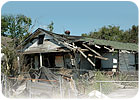
My first visit to New Orleans was in February 1990. I was a new labor trustee on a pension and health and welfare plan, and I was there to attend training classes at the International Foundation of Employee Benefits Conference. I was so jazzed, pun fully intended, about experiencing the town for the first time. As someone who likes to eat, listen to music and generally just have a good time can attest, she did not disappoint. From the sights and sounds of Bourbon Street, to the chickaree laced coffee and beignets at Café du Monde, it certainly lived up to its hype.
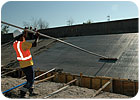
Finishing new concrete footing for levees.
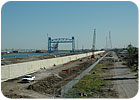
Bird's eye view of levee, Ninth Ward to the right.
What I saw
I was in New Orleans to do a success story on some of our Job Corps students who had returned to the area to work as cement masons on the levy. The two young men had fled the area prior to hurricane Katrina's arrival and with nowhere else to live, they enrolled in our Job Corps Training Program. Job Corps is a federally sponsored program that provides disadvantaged youth a free in-residence training environment. In other words, an enrollee can live on our campus, which are similar to military installations, while they participate in academic and vocational training. These two young men, like hundreds of other Katrina refugees, spent seven months living on a Job Corps campus and returned to New Orleans as apprentice cement masons to help in the rebuilding of the area. When I caught up to them, they were working on a new pumping station and living in a make-shift trailer park north of town.While in the area, I wanted to see first hand how New Orleans was faring after the storm. At first, I drove around some of my old haunts. Bourbon Street and Café du Monde looked as if nothing had ever happened. Tourists were sipping their coffee and wearing beads. The convention center had a few construction trucks and scaffoldings scattered here and there but nothing one wouldn't expect to see from a small remodeling project. The Superdome, temporary home to 10,000 or so residences who were stranded in the city, was getting a new roof, a big banner hanging off the side promised its "Re-Opening in September 2006." At first I said to myself, this isn't too bad. Unfortunately, I was in for a sad surprise.
As we drove over the bridge that transverses the canal, I got a birds-eye view of where the levee had breeched and how vulnerable the homes of the Ninth Ward were to the wall of water that flooded this blue-collar neighborhood last year. As we turned left off the main drag and into the heart of the neighborhood, I cannot honestly tell you what I expected to see. But whatever notion I may have had was completely blown away by the reality of what is now nothing but a ghost town.
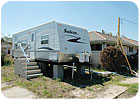
Only FEMA trailer I witnessed in Ninth Ward.
Homes crushed
Hundreds, maybe thousands, of homes had floated up off of their foundations and were swept away in the rushing water, slamming into other homes or simply collapsing under the force of the onslaught. Vehicles of all kind thrown around like a child's matchbox cars, left upside down, atop one another, crushed, and even a few left perched high up in trees. The homes that were not completely demolished remain as they did the day the water receded. Imagine everything you own: clothing, food, appliances, family pictures, your children's toys-everything-being thrown into a giant washing machine, run on full tilt, and then spilled back out onto your floor.Now imagine it being left there to bake, day upon day for nine months worth. That is what I saw and smelled in dozens of homes I entered in the Ninth Ward. Many homes had been swamped out, the old lath and plaster removed from the studs and everything cleared out and piled at the street. But for no apparent reason, right next door there are homes, where the putrid mush, that was once a family's most precious belonging, lay rotting in the hot humid conditions of the Deep South.
Just before the levees broke, residents of the Ninth Ward thought they had already seen the worst Katrina had to offer and thought they had survived relatively unscathed. Little did they know that a wall of water was about to barrel down upon their neighborhood. By that time, it was too late to evacuate, so most simply climbed to their second floor to escape the rising water. Those without a second floor retreated up into their attic thinking the water wouldn't get any higher. But they were wrong, deadly wrong.
Many perished, trapped in their own attic with no escape available to them. I recall one news clip where a man had blown a hole in his roof with a shotgun from the inside out; many others were not so well equipped. Markings on each dwelling indicate the time and date the house was searched and if any one was found, alive or deceased. Water mains were still broken and fresh water was spilling from numerous broken pipes and pouring down storm drains. There is no electricity. There was one Christian group of a dozen or so teenagers with rakes and brooms doing what they could to help.
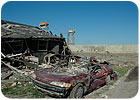
Ground view of repaired levee standing in Ninth Ward.
What's left
The roads of the Ninth Ward are now as clear as the streets in front of your own home. Someone has organized work crews to come in and clear the streets so that residents can gain access to their property. But beginning at the property line, the entire area remains very much like it was on the day the water receded. Many of the families have fled to stay with distant relatives throughout the country, some may never return. Some remain in the area but are unable to repair or rebuild because they either did not have proper insurance or their insurance carrier has not yet paid off.Most residents had insurance coverage protecting their property in the event of hurricane wind damage but not from flood damage. The wind from the hurricane drove the water up the canal, which eventually eroded the levee, causing wide spread flooding. And without insurance money, the poor working class of the Ninth Ward cannot rebuild. In fact, I saw only one of the now infamous FEMA trailers in the entire area that was occupied by a family who was working on their own home.
The Ninth Ward was not the only area that suffered flooding damage from Katrina. I took a ride out to see upper middleclass neighborhoods around Lake Pontchartrain. The area only suffered flooding two to four feet inside the homes along the lake and its canals. But with other resources in hand, these residents are rebuilding at a fast and furious pace. FEMA trailers were everywhere, maybe one for every third home. Construction dumpsters were overflowing with removed building materials, and there were yard signs-and even full billboards-advertising for roofing and drywall contractors. I spoke to one 20-year-old man from Wisconsin who had driven his pickup all the way down with barely $100 left to his name when he arrived and nowhere to sleep. He had come on the hopes of securing employment.
The homeowners and contractors I spoke with around Lake Pontchartrain said the same issues exist with insurance carriers in this upscale neighborhood as in the Ninth Ward. Companies were refusing to pay off because so much of the damage was caused by water and not wind. The difference that is spurring on the repairs is that these residents have other resources.
There has been plenty of finger pointing about Katrina. But what has haunted me most is that nothing, absolutely nothing, was being done in the Ninth Ward. The remnants of the lives of thousands of families remain to this day, washed, dumped out, and rotting in the hot Louisiana sun.



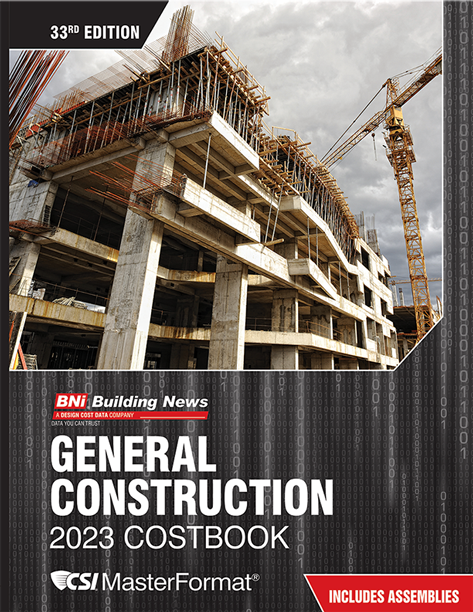
Report Abusive Comment